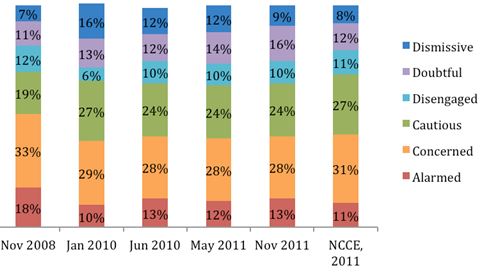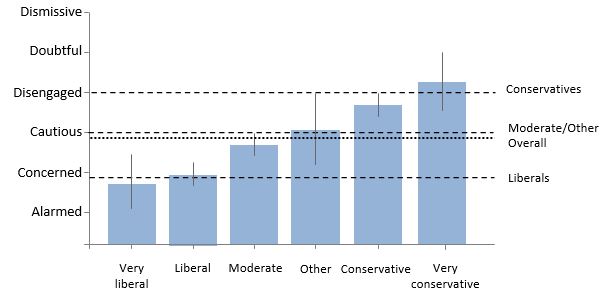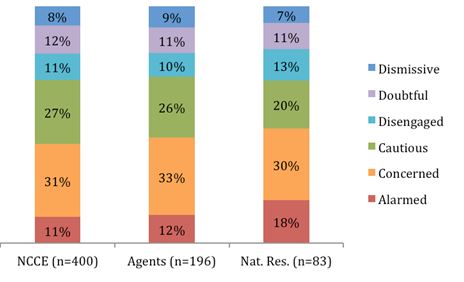 |
February 2014
|
February 2014 // Volume 52 // Number 1 // Research In Brief // v52-1rb1
North Carolina Cooperative Extension Professionals' Climate Change Perceptions, Willingness, and Perceived Barriers to Programming: An Educational Needs Assessment
Abstract
The educational needs assessment reported here measured North Carolina Cooperative Extension (NCCE) professionals' perceptions of global warming and identified barriers to climate change programming. Survey results from 400 NCCE professionals show 70% are cautious, concerned, or alarmed about global warming. Liberal and female Extension professionals were more likely to be alarmed and concerned than their conservative and male counterparts. Respondents indicated willingness to engage in programming, but need in-service training to address conflicts, gather information, and emphasize relevancy. NCCE professionals perceive lack of audience interest, conflicts within available information, and lack of applied information as the greatest barriers to climate change programming.
Introduction
Extension is considered "one of the world's most successful change agencies" (Rogers, 2003). Extension's existing framework of reviewing and translating scientific research, maintaining relationships with key stakeholders, and disseminating actionable information creates tremendous potential for a widespread climate education and adaptation effort. Forests and crops are both vulnerable to a changing climate (e.g., more expected damage from pests, wildfires, and severe weather) and are able to be managed differently to adapt to the impacts of climate change (e.g., Spittlehouse, 2005). As such, Extension is well positioned to educate their audiences about options for forest and agricultural adaptation in response to global climate change.
Climate change beliefs and concerns vary dramatically across the American public, spanning a spectrum from alarmed to dismissive attitudes, and it is unknown to what degree Extension professionals mirror their target audiences (Leiserowitz, Maibach, Roser-Renouf, & Hmielowski, 2012; Maibach, Roser-Renouf, & Leiserowitz, 2009). Although the general public's perceptions of climate change are well documented, few studies focus specifically on the beliefs and perceptions of agriculture and natural resource professionals, landowners, and other key groups. Notable exceptions include recent studies of climate change perceptions of the New York Society of American Foresters (Labriole & Luzadis, 2011), U.S. Forest Service (Riddle, 2011), and farmers in Nevada (Liu, Smith, & Safi, 2014) and Iowa (Arbuckle, Morton, & Hobbs, 2013) that add to this growing literature.
Purpose
Assuming that Extension is a good mode of delivery for adaptation information, particularly to family-owned forests and agricultural operations, we developed an educational needs assessment (McCawley, 2009) to evaluate Extension professionals'
- Global warming perceptions,
- Willingness to participate in climate change-related Extension programs, and
- Perceived barriers to incorporating climate change into new and existing programs.
Methods
We surveyed 646 North Carolina Cooperative Extension (NCCE) professionals using a Web-based survey and purposive sampling in the fall of 2011. The survey was part of a region-wide effort led by Pine Integrated Network: Education, Mitigation, and Adaptation Project (PINEMAP) collaborators at the University of Florida's School of Forest Resources and Conservation to survey several Southeastern states (Adams, Monroe, Plate, & Wojcik, 2012). Our survey design and implementation followed the surveying procedure outlined by Dillman, Smyth, and Christian (2009) for Internet and e-mail surveys, which includes repeated, personalized contact with potential respondents. In our case, repeated, personalized contact included North Carolina logos, an introductory email, use of NCCE professionals' names, repeated reminders over a 4-week period to partial and non-respondents, and names of study collaborators and Cooperative Extension administration on all communications; this approach helped increase response rate (Monroe & Adams, 2012).
Respondents answered 48 multiple-choice questions concerning demographic and professional information; respondents' understanding, beliefs, and engagement with climate change; and perceived barriers to climate change programming.
We employed the Six Americas segmentation analysis developed by the Yale Project on Climate Change and the Center for Climate Change Communication at George Mason University (Leiserowitz, Maibach, Roser-Renouf, & Smith, 2008). Six Americas is based on 15 core questions that measure respondents' beliefs, issues involvement, behavior, and preferred societal response in relation to global warming (Maibach, Roser-Renouf, & Leiserowitz, 2009). The analysis segments respondents into six groups, ranging from alarmed to dismissive, categorized by firmness of opinion, sense of urgency, and engagement (Table 1).
Our core Six Americas survey questions were identical to several national surveys, including the use of global warming in place of other phrases (e.g., climate change or climate variability), to facilitate comparison of our results to Six Americas surveys of the American public. Global warming is arguably a less ambiguous term; climate change encompasses many ideas of past and present natural variations and anthropogenic causes of climatic change. Despite their nuances, global warming and climate change have been used interchangeably with the public (Leiserowitz, Smith, & Marlong, 2010; Villar & Krosnick, 2010). Our survey defined global warming as the increase in the world's average temperature over the past 150 years that may accelerate in the future and cause a change in the world's climate system. Despite the specific definition, respondents may have used their own interpretation of this term.
Following the Six Americas analysis, we evaluated whether Extension professionals' demographic and professional characteristics affected respondents' global warming perceptions using an analysis of variance (ANOVA) or a Welch robust test with Dunnet's C post hoc tests when there were unequal variances among groups.
| Six Americas Segmented Group | Description |
| Alarmed | convinced global warming is a serious and urgent threat; highly engaged; most likely to change behavior |
| Concerned | convinced global warming is a serious threat; somewhat engaged; less likely to change behavior |
| Cautious | believe global warming is a problem but not a personal or urgent threat |
| Disengaged | give little thought to global warming; change beliefs easily; not engaged |
| Doubtful | believe global warming may or may not be happening |
| Dismissive | firmly believe global warming is not occurring; highly engaged |
|
Leiserowitz, Maibach, Roser-Renouf, & Smith (2008) |
|
Finally, we asked respondents what they perceive as being barriers to climate change programming. We presented respondents with a list of potential reasons and asked them to rate the extent to which each reason was limiting. The list of potential reasons was developed with the help of 32 Extension specialists in five states.
Results and Discussion
We had a total response rate of 69% (n=443), but only 62% (n=400) of responses were complete and usable for the Six Americas segmentation analysis. When contacted, partial and non-respondents indicated that they either did not consider themselves Extension agents or did not have sufficient time to take or complete the survey. Tests for common survey bias issues (e.g., comparison of first and last 50 respondents to assess non-response bias) found no significant differences. Hence, we assumed that our sample is representative of NCCE.
Global Warming Perceptions
We found a wide array of beliefs and engagement with global warming during the Six Americas segmentation analysis. Respondents were skewed toward belief in global warming, with nearly 70% of respondents classified as alarmed, concerned, or cautious. These results are consistent with Six Americas segmentation analyses of the American public (Figure 1).
Figure 1.
Six Americas Segmentation Analysis: Comparison of the American Public in November 2008, January 2010, June 2010, May 2011, and November 2011 and NCCE

Data from Leiserowitz, Maibach, Roser-Renouf, & Hmielowski, 2012
We found that political orientation and gender varied significantly among the Six Americas segments. The most commonly reported political view was Moderate (37%), followed by Conservative (34%) and Liberal (17%). Liberal respondents were much more likely to be alarmed, concerned, or cautious than conservatives (Welch statistic=25.146, p<0.0001; Figure 2). This finding is consistent with results from other climate change-related surveys (Labriole & Luzadis, 2011; McCright, 2011). The average Six Americas score for females fell between concerned and cautious segments; the average score for males placed them between cautious and disengaged (F=19.094, p<0.0001). This trend between global warming attitudes, political orientation, and gender is consistent with national surveys, which suggests that liberals and women express opinions more consistent with the climate science community than their conservative, male counterparts (McCright, 2010; McCright, 2011).
Figure 2.
Six Americas Segmentation and Self-identified Political Orientation. Dashed Lines are Group and Overall Means. Error Bars are 95% Confidence Intervals

We also evaluated how the entire NCCE compared to agents and natural resource specialists within NCCE. Professionals working primarily in the natural resource content area appear to be the most alarmed about global warming (Figure 3). This finding probably reflects demographic patterns because the natural resource group had fewer conservative respondents than other content area groups. Because agents and natural resource specialists are nested within NCCE and not independent samples, we could not perform an ANOVA test for equality among group means. Extension agents working primarily in other content areas (e.g., agriculture and forestry) had too small sample sizes to draw any conclusions. Results from other state Extension agencies that received this survey indicate that natural resource specialists involved in environmental education are more likely to be alarmed or concerned than agriculture, wildlife, and forestry agents (Adams, Monroe, Plate, & Wojcik, 2012). We did not find any significant differences among Six Americas segments for other professional characteristics, including years of experience, role in Extension, involvement in programming, and urban versus rural work settings.
Figure 3.
Six Americas Analysis of NCCE Professionals' Perceptions of Global Warming by Position (Agents) and Content Area (Natural Resources)

Willingness for Climate Change Programming
Fifteen percent of respondents reported they had previously participated in climate programs, and 10% had experience developing climate change materials or programs. Most Extension professionals are at least somewhat willing to participate in efforts to incorporate climate change messages into programming (Table 3). The disparity between past participation and willingness may stem from the lack of climate change programming and continuing education available to Extension professionals. A lesser majority of respondents would participate in a regional project addressing climate change, yet less than half were willing to engage in its development.
| Type of Participation | Very Willing | Somewhat Willing | Not at All Willing |
| Participate in Continuing Education | 23% (92) | 59% (239) | 18% (72) |
| Develop Materials or Programs | 14% (56) | 55% (220) | 30% (121) |
| Participate in Regional Project | 16% (64) | 50% (200) | 34% (137) |
| Develop a Regional Project | 10% (41) | 36% (145) | 53% (212) |
| Use Regionally-Developed Materials | 27% (108) | 53% (209) | 20% (80) |
|
Note: Number of responses indicated in parentheses. |
|||
Barriers to Climate Change Programming
Extension professionals identified the most prominent barriers to climate change programming by rating each potential limiting factor from a "great deal" limiting to "not at all" limiting. The most limiting factors are lack of audience interest (53%), available information conflicting (47%), and not enough applied information (46%) (Table 4). The view that climate change is not relevant to Extension professionals' program areas may be related to the lack of applied information. Furthermore, 74% of Extension professionals requested additional information to form a firm opinion about global warming. Continuing education programs for Extension professionals can address these barriers by presenting basic and applied information, emphasizing relevancy, and promoting climate change tools for agriculture and forestry often available from state climate offices.
| Major Limiting Factors | Great Deal to a Moderate Amount | Only a Little to Not at All | Don't Know |
| Lack of audience interest | 53% (204) | 28% (109) | 19% (72) |
| Available information is conflicting | 47% (181) | 28% (109) | 25% (95) |
| Not enough applied information available | 46% (176) | 33% (126) | 22% (84) |
| Not enough basic information available | 40% (155) | 39% (150) | 21% (81) |
| Not relevant to my program area | 40% (153) | 49% (190) | 11% (41) |
| Too much information to interpret effectively | 40% (152) | 38% (144) | 23% (86) |
| Lack of program funding | 38% (146) | 38% (144) | 24% (90) |
| Scientific information is not sound | 28% (108) | 41% (157) | 31% (118) |
| Programming not part of my job | 27% (100) | 64% (238) | 9% (34) |
| Personal beliefs | 18% (67) | 69% (264) | 13% (50) |
| Workplace conflicts | 15% (57) | 69% (263) | 16% (63) |
| Note: Number of responses indicated in parentheses. | |||
Conclusions and Implications
- The NCCE reflects the American public in its segmentation among the Six Americas: nearly 70% of NCCE professionals are on the cautious-concerned-alarmed side of the Six Americas spectrum.
- We found a gap between willingness to incorporate climate change materials into programming and experience in doing so. This disparity likely stems from the lack of continuing education programs focused on climate change. It is unknown how many willing Extension professionals have programming responsibilities.
- The top three barriers to climate change programming are lack of audience interest, conflicts within available information, and lack of applied information.
- Extension may take several approaches to implementing and integrating climate change into training and programming. Extension professionals hold a wide array of opinions about global warming. As such, Extension leadership may choose to target alarmed and concerned agents for climate change training and delivery. Alternatively, they may choose to focus on likely impacts of climate change and omit phrases such as global warming and climate change to appeal to more conservative professionals and likewise, conservative target audiences. Participation of conservative and male Extension professionals may be increasingly important where this demographic group comprises a majority in a content area (e.g., agriculture). Regardless of the strategy, Extension programs will need to
- Provide training opportunities for willing agents (e.g., continuing education programs or Extension climate programs such as in Florida [Fraisse, Breuer, Zierden, & Ingram, 2009]).
- Prepare training and education materials with an applied, adaptive focus (e.g., applied researchers and Extension agents can work together to resolve apparent and actual conflicts in climate information, and present research and promote climate change tools relevant to target audiences), and
- Adopt strategies for implementing climate change programming that will have the maximum effect on target audiences (i.e., prioritize audiences for climate change-related programming based on receptivity or incorporate a climate adaptation message into their existing programs to achieve the greatest impact).
- Our survey did not ask Extension professionals about how they would overcome perceived barriers or about their skills with various programming issues, such as addressing controversy and responding to dissent, that are intrinsic to discussions about climate and global warming. Our survey also does not directly address the needs of Extension's audience. Future studies and trainings should consider further exploration of programming barriers, how to overcome barriers, and what specific information Extension's audiences desire.
Acknowledgments
The Pine Integrated Network: Education, Mitigation, and Adaptation Project (PINEMAP) is a Coordinated Agricultural Project funded by the USDA National Institute of Food and Agriculture, Award #2011-68002-30185. This manuscript is a product of PINEMAP student Aaron Vuola's Master of Science, Forestry and Environmental Resources thesis at North Carolina State University, May 2012 <http://repository.lib.ncsu.edu/ir/bitstream/1840.16/7589/1/etd.pdf>.
References
Adams, D. C., Monroe, M. C., Plate, R., & Wojcik, D. (2012). The Six Americas of climate change: Perceptions of southeast Extension professionals. Retrieved from: http://www.pinemap.org/publications/research-summaries/extension/Six_Americas.pdf
Arbuckle, J. G., Jr., Morton, L. W., & Hobbs, J. (2013). Farmer beliefs and concerns about climate change and attitudes toward adaptation and mitigation: Evidence from Iowa. Climatic Change 118(3-4): 551-563.
Dillman, D. A., Smyth, J. D., & Christian, L. M. (2009). Internet, mail and mixed-mode surveys: The tailored design method (3rd ed.). Hoboken, NJ: John Wiley & Sons, Inc.
Fraisse, C. W., Breuer, N. E., Zierden, D., & Ingram, K. T. (2009). From climate variability to climate change: Challenges and opportunity to extension. Journal of Extension [On-line], 47(2) Article 2FEA9. Available at: http://www.joe.org/joe/2009april/a9.php
Labriole, M. M., & Luzadis, V. A. (2011). New York Society of American Foresters' perceptions of climate change. Journal of Forestry 109(2): 89-94.
Leiserowitz, A., Maibach, E., Roser-Renouf, C., & Smith, N. (2008). Global warming's "six Americas": An audience segmentation. Yale University and George Mason University. New Haven, CT and Fairfax, VA: Yale Project on Climate Change Communication. Retrieved from: http://www.climatechangecommunication.org/images/files/GlobalWarmingsSixAmericas2009c.pdf
Leiserowitz, A., Smith, N., & Marlong, J.R. (2010). Americans' knowledge of climate change. Yale University, New Haven, CT: Yale Project on Climate Change Communication. Retrieved from: http://environment.yale.edu/climate/files/ClimateChangeKnowledge2010.pdf
Leiserowitz, A., Maibach, E., Roser-Renouf, C., & Hmielowski, J. (2012). March 2012 & November 2011. Yale University and George Mason University. New Haven, CT: Yale Project on Climate Change. Retrieved from: http://environment.yale.edu/climate/files/Six-Americas-March-2012.pdf
Liu, Z., Smith, W. J., Jr., & Safi, A. S. (2014). Rancher and farmer perceptions of climate change in Nevada, USA. Climatic Change 122(1-2): 313-327.
Maibach, E., Roser-Renouf, C., & Leiserowitz, A. (2009). Global warming's six Americas 2009: An audience segmentation analysis. Yale University and George Mason University. New Haven, CT: Yale Project on Climate Change. Retrieved from: www.americanprogress.org/issues/2009/05/6americas.html
McCawley, P. F. (2009). Methods for conducting an educational needs assessment: Guidelines for Cooperative Extension System professionals. Bulletin 870. Moscow, ID: University of Idaho Extension. Retrieved from: http://www.cals.uidaho.edu/edcomm/pdf/BUL/BUL0870.pdf
McCright, A. (2010). The effects of gender on climate change knowledge and concern in the American public. Population and Environment 32(1): 66-87.
McCright, A. (2011). Political orientation moderates Americans' beliefs and concern about climate change. Climate Change 104(2): 243-253.
Monroe, M. C., & Adams, D. C. (2012). Increasing response rates to Web-based surveys. Journal of Extension [On-line] 50(6) Article 6TOT7. Available at: http://www.joe.org/joe/2012december/tt7.php
Riddle, A. A. (2011). Climate change and the U.S. Forest Service: Opportunities for adaptation and mitigation. (Unpublished thesis). North Carolina State University, North Carolina. Retrieved from: http://repository.lib.ncsu.edu/ir/bitstream/1840.16/6619/1/etd.pdf
Rogers, E. M. (2003). Diffusions of Innovations (5th ed.). New York, NY: The Free Press.
Spittlehouse, D. L. (2005). Integrating climate change adaptation into forest management. The Forestry Chronicle 81(5): 691-695.
Villar, A., & Krosnick, J. A. (2010). Global warming vs. climate change, taxes vs. price: Does word choice matter? Climate Change 105(1): 1-12.




